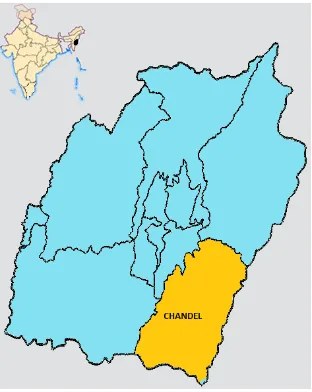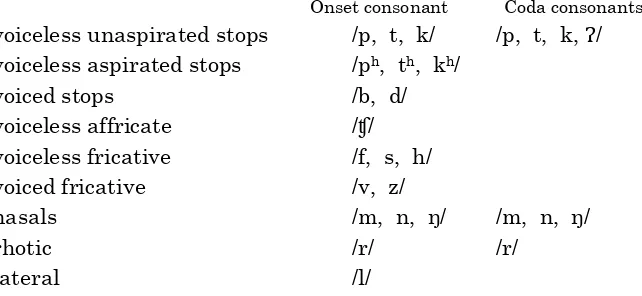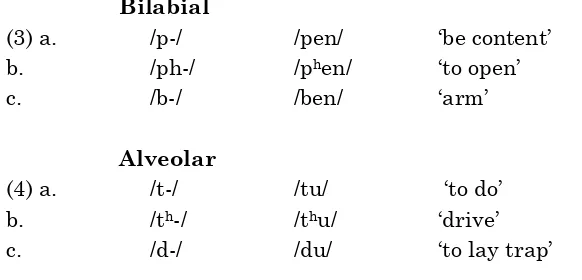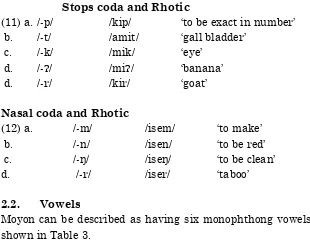ISSN 2286-4822 www.euacademic.org
Impact Factor: 3.1 (UIF) DRJI Value: 5.9 (B+)
Segmental Phonology of Moyon
N. RINGRII MOYON
M.A. Linguistics Manipur University Canchipur, Imphal-West, Manipur India
Abstract:
Moyon is a Tibeto-Burman language, spoken by about 2000 people in Chandel District, Manipur, Northeast India. The name Moyon refers to the community as well as the language. The people however, referred to themselves as “Bujuur”. Moyon is an under documented language and has remained little known. Though ethnically affiliated to the Naga group, Moyon linguistically belongs to the North-Western Kuki-Chin branch (NWKC), formerly referred to as the “Old Kuki” branch.
This paper presents a preliminary analysis of the segmental phonology of Moyon language. In this paper, an inventory of the phonemes of Moyon, specifying their distribution and showing diagrammatically the consonant and vowel phonemes along with their place and manner of articulation are discussed as part of articulatory description.
Key words: Tibeto-Burman, Northwest Kuki-Chin, Moyon, Segmental Phonology
1. Introduction
Latitude and 93o50' E Longitude. It is the border district of the state. Its neighbors are Myanmar (erstwhile Burma) to the east and south, Ukhrul district to the northeast, Churachandpur district to the west and south, and Thoubal district to the north. It is about 64 km. away from Imphal, the capital of Manipur. The district is inhabited by several communities. Prominent communities in the district are Anal, Chothe, Lamkang, Maring, Monsang, Moyon, Paite, Tarao, Thadou, and Zou etc. This paper presents the segmental phonology of Moyon language. The analysis is based on data elicited from native speakers of the language.
Fig. Map (Not to scale) of Manipur, India showing Chandel District.
2. Segmental Phonemes
are two types of segmental phonemes, namely, consonants and vowels.
2.1. Consonants
There are twenty consonant phonemes in Moyon. The phonemic consonant inventory of Moyon by place and manner of articulation is given in Table 1.
Table 1. Moyon Consonantal phonemes
2.1.1. Distribution of consonants
The distinctive consonants that can occur as onset and coda are given below in Table 2:
Onset consonant Coda consonants voiceless unaspirated stops /p, t, k/ /p, t, k, Ɂ/ voiceless aspirated stops /ph, th, kh/
voiced stops /b, d/
voiceless affricate /ʧ/ voiceless fricative /f, s, h/ voiced fricative /v, z/
nasals /m, n, ŋ/ /m, n, ŋ/
rhotic /r/ /r/
lateral /l/
Table 2. Moyon consonantal phonemes showing syllable onsets and codas.
Bilabial Labio- dental
Alveolar Post- Alveolar
Velar Glottal
Stop/Plosive p b ph
t d th
k kh
Ɂ
Nasal m n ŋ
Trill r
Fricative f v s z h
Affricate ʧ
Lateral Approximant
Table 2. shows that all of the consonants can occur as syllable onsets, while 8 can occur as codas.
2.1.2. Onset consonants
Stops
The contrast between voiceless unaspirated stops are shown in (1) with the help of minimal pairs.
Unaspirated stops
(1) a. /p-/ /par/ ‘touch’ b. /t-/ /tar/ ‘to be old’ c. /k-/ /kar/ ‘to save’
The contrast between voiceless aspirated stops are shown in (2) with the help of minimal pairs.
Aspirated
(2) a. /ph-/ /phen/ ‘to open’
b. /th-/ /then/ ‘to give light’
c. /kh-/ /khen/ ‘to waylay’
Moyon also contrasts voiceless unaspirated, voiceless aspirated and voiced stops at bilabial, alveolar and velar place of articulation as shown in (3), (4) and (5) below.
Bilabial
(3) a. /p-/ /pen/ ‘be content’ b. /ph-/ /phen/ ‘to open’
c. /b-/ /ben/ ‘arm’
Alveolar
(4) a. /t-/ /tu/ ‘to do’
b. /th-/ /thu/ ‘drive’
Velar
(5) a. /k-/ /ki/ ‘to pull’
b. /kh-/ /khi/ ‘leg’
Nasals
The three nasals of Moyon are illustrated with the help of minimal pairs in (6) below.
(6) a. /m-/ /me/ ‘face’
b. /n-/ /ne/ ‘younger sibling’
c. /ŋ-/ /ŋe/ ‘to like’
Fricatives and Affricate
The contrast between the fricatives at different places of articulation is provided with the help of minimal pair in (7), (8) and (9) below.
Labio-dental fricatives
(7) a. /f-/ /fwu/ ‘noise’
b. /v-/ /vwu/ ‘to fart’
Alveolar fricatives
(8) a. /s-/ /sar/ ‘sister’
b. /z-/ /zar/ ‘to scatter’
Alveolar and glottal fricatives (9) a. /s-/ /sem/ ‘distribute’
b. /h-/ /hem/ ‘to pound’
c. /z-/ /zar/ ‘to scatter’
d. /h-/ /har/ ‘to despise’
Lateral and rhotic
(10) a. /r-/ /ram/ ‘land’
b. /l-/ /lam/ ‘road/path’
2.1.3. Coda consonants
As shown in Table 2. the coda may consist of the stops /p, t, k/ , nasals /m, n, ŋ/ and rhotic /r/. The distribution of the voiceless unaspirated stops, nasals and rhotic can be established in coda position as in (11) and (12) below.
Stops coda and Rhotic
(11) a. /-p/ /kip/ ‘to be exact in number’ b. /-t/ /amit/ ‘gall bladder’
c. /-k/ /mik/ ‘eye’
d. /-Ɂ/ /miɁ/ ‘banana’
d. /-r/ /kir/ ‘goat’
Nasal coda and Rhotic
(12) a. /-m/ /isem/ ‘to make’
b. /-n/ /isen/ ‘to be red’
c. /-ŋ/ /iseŋ/ ‘to be clean’
d. /-r/ /iser/ ‘taboo’
2.2. Vowels
Moyon can be described as having six monophthong vowels as shown in Table 3.
Table 3. Moyon Vowels
The Moyon vowel phonemes may be described in as follows. /i/ = high, front, unrounded vowel
/u/ = high, back, rounded vowel /e/ = mid, front, unrounded vowel
Front Central Back
High i u
Mid e ɘ o
/o/ = mid, back, rounded vowel /a/ = low, central, unrounded vowel
The different phonemic status of these six vowels can be established on the basis of the following minimal and near minimal pairs.
(13) a. /i/ /pir/ ‘dust’
b. /u/ /pur/ ‘gather’
c. /e/ /per/ ‘strong’
d. /ɘ/ /pɘr/ ‘to drop-by’
e. /o/ /apor/ ‘foam’
f. /a/ /par/ ‘to bloom’
Concluding remarks
This paper presents a preliminary analysis of Moyon segmental phonology. As a result, this paper cannot claim to be an exhaustive study approaching the full-scale phonology of the language. Altogether, 20 consonants and six vowels have been established. Of the total number of consonants, only the voiceless unaspirated stops /p, t, k, Ɂ/, the nasals /m, n, ŋ/ and the rhotic /r/ occur in coda position.
BIBLIOGRAPHY:
Crystal, David. 2003. A Dictionary of Linguistics and Phonetics. Blackwell Publishing Ltd.
Katamba, F. 1996. An Introduction to Phonology. New York: Longman Publication.
Lacy, P. Le. 2007. The Cambridge Handbook of Phonology. New York: Cambridge University Press.
Odden, David. 2005. Introducing phonology. New York: Cambridge University Press.



